Audit Planning: Impact of Covid-19 on Financial Audit
VerifiedAdded on 2023/01/06
|7
|1906
|84
Report
AI Summary
This report examines the impact of Covid-19 on financial audit planning, focusing on the case of Virgin Australia. It begins by assessing the effects of the pandemic on the airline industry, including inherent risks such as geopolitical volatility, economic slowdown, and supply chain disruptions. The report then analyzes the development and assessment of audit risk, considering financial, reputational, regulatory, and operational impacts. It identifies the types of evidence needed for audit procedures, including comparisons of financial statements, invoices, and receipts. Furthermore, the report assesses Virgin Australia's status as a going concern, as per ASA 570. The report also outlines the planning considerations for the audit, including the identification of inherent risks related to financial instruments, revenue recognition, lease contracts, accounting policy changes, financial instrument disclosure, and inventory valuation. The analysis highlights the importance of adhering to relevant accounting standards such as AASB 9, AASB 15, AASB 16, AASB 108, AASB 7, and AASB 102. The report concludes by emphasizing the challenges and complexities of conducting audits in the current environment.
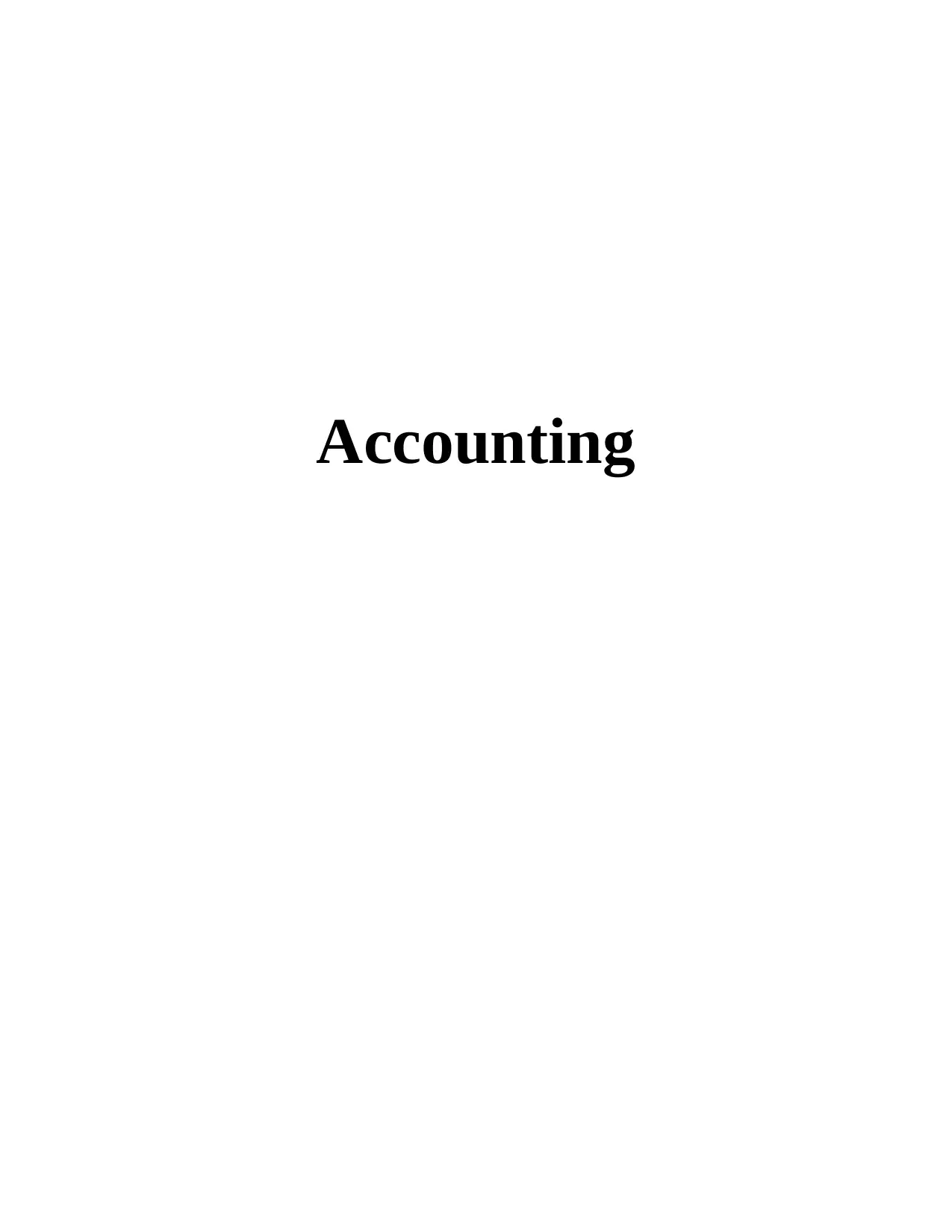
Accounting
Paraphrase This Document
Need a fresh take? Get an instant paraphrase of this document with our AI Paraphraser
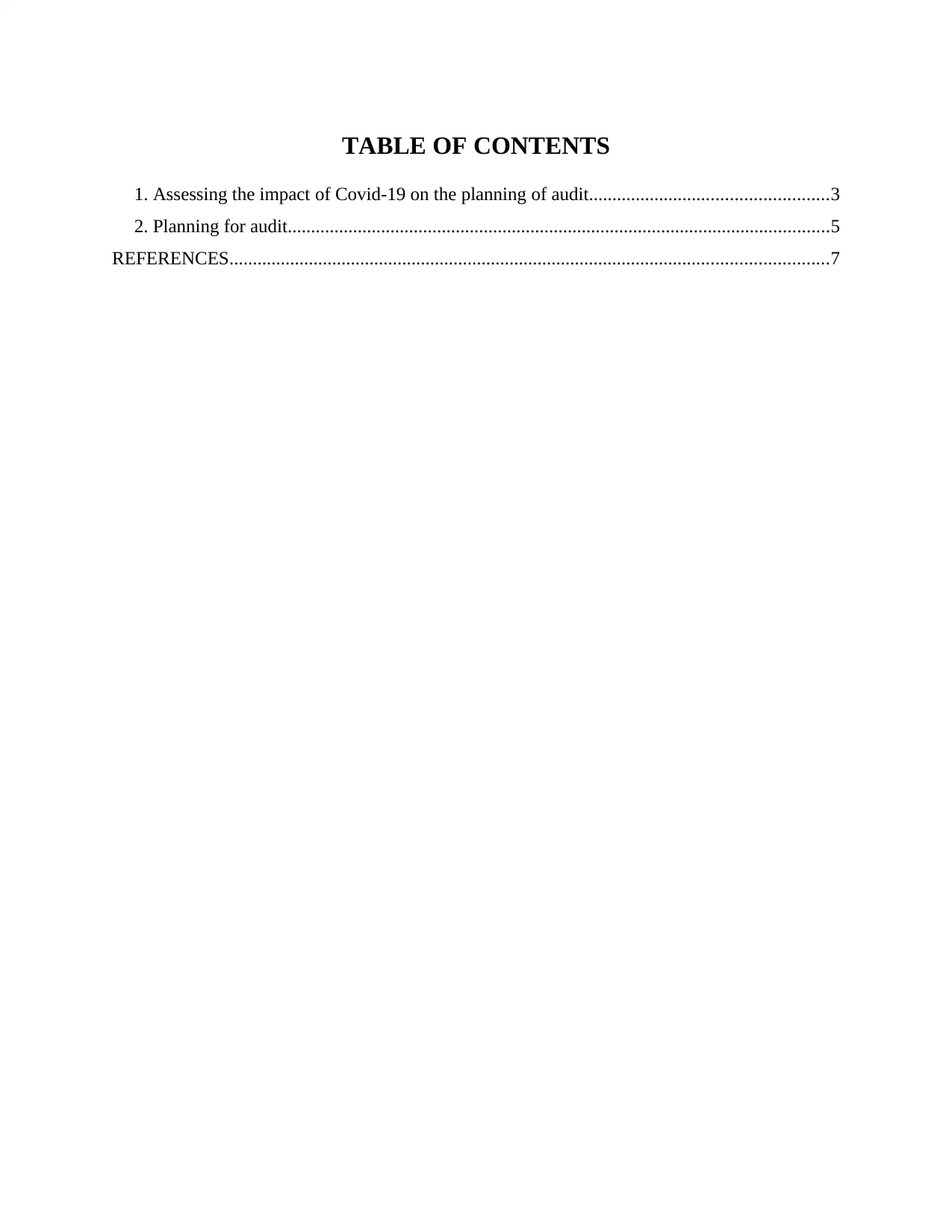
TABLE OF CONTENTS
1. Assessing the impact of Covid-19 on the planning of audit...................................................3
2. Planning for audit....................................................................................................................5
REFERENCES................................................................................................................................7
1. Assessing the impact of Covid-19 on the planning of audit...................................................3
2. Planning for audit....................................................................................................................5
REFERENCES................................................................................................................................7
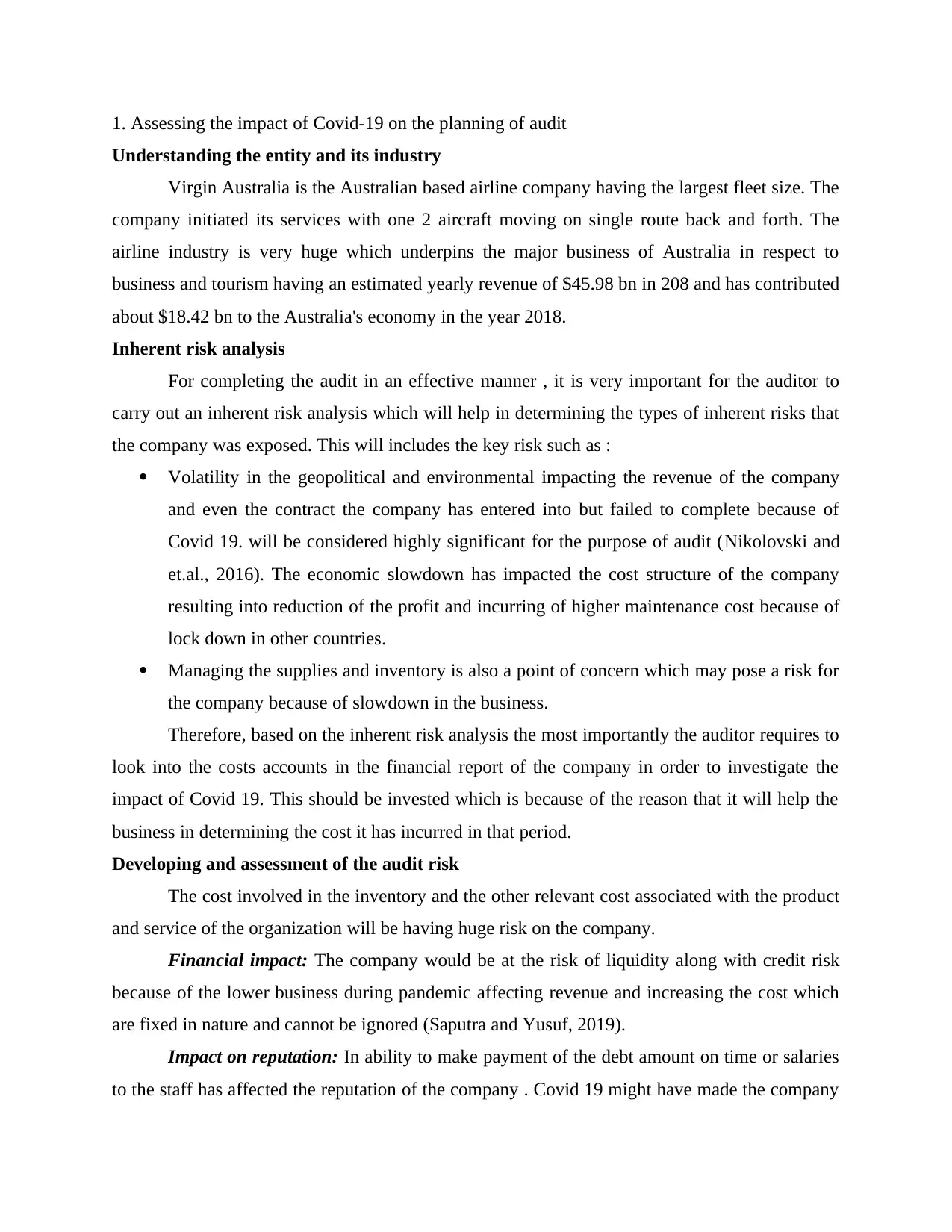
1. Assessing the impact of Covid-19 on the planning of audit
Understanding the entity and its industry
Virgin Australia is the Australian based airline company having the largest fleet size. The
company initiated its services with one 2 aircraft moving on single route back and forth. The
airline industry is very huge which underpins the major business of Australia in respect to
business and tourism having an estimated yearly revenue of $45.98 bn in 208 and has contributed
about $18.42 bn to the Australia's economy in the year 2018.
Inherent risk analysis
For completing the audit in an effective manner , it is very important for the auditor to
carry out an inherent risk analysis which will help in determining the types of inherent risks that
the company was exposed. This will includes the key risk such as :
Volatility in the geopolitical and environmental impacting the revenue of the company
and even the contract the company has entered into but failed to complete because of
Covid 19. will be considered highly significant for the purpose of audit (Nikolovski and
et.al., 2016). The economic slowdown has impacted the cost structure of the company
resulting into reduction of the profit and incurring of higher maintenance cost because of
lock down in other countries.
Managing the supplies and inventory is also a point of concern which may pose a risk for
the company because of slowdown in the business.
Therefore, based on the inherent risk analysis the most importantly the auditor requires to
look into the costs accounts in the financial report of the company in order to investigate the
impact of Covid 19. This should be invested which is because of the reason that it will help the
business in determining the cost it has incurred in that period.
Developing and assessment of the audit risk
The cost involved in the inventory and the other relevant cost associated with the product
and service of the organization will be having huge risk on the company.
Financial impact: The company would be at the risk of liquidity along with credit risk
because of the lower business during pandemic affecting revenue and increasing the cost which
are fixed in nature and cannot be ignored (Saputra and Yusuf, 2019).
Impact on reputation: In ability to make payment of the debt amount on time or salaries
to the staff has affected the reputation of the company . Covid 19 might have made the company
Understanding the entity and its industry
Virgin Australia is the Australian based airline company having the largest fleet size. The
company initiated its services with one 2 aircraft moving on single route back and forth. The
airline industry is very huge which underpins the major business of Australia in respect to
business and tourism having an estimated yearly revenue of $45.98 bn in 208 and has contributed
about $18.42 bn to the Australia's economy in the year 2018.
Inherent risk analysis
For completing the audit in an effective manner , it is very important for the auditor to
carry out an inherent risk analysis which will help in determining the types of inherent risks that
the company was exposed. This will includes the key risk such as :
Volatility in the geopolitical and environmental impacting the revenue of the company
and even the contract the company has entered into but failed to complete because of
Covid 19. will be considered highly significant for the purpose of audit (Nikolovski and
et.al., 2016). The economic slowdown has impacted the cost structure of the company
resulting into reduction of the profit and incurring of higher maintenance cost because of
lock down in other countries.
Managing the supplies and inventory is also a point of concern which may pose a risk for
the company because of slowdown in the business.
Therefore, based on the inherent risk analysis the most importantly the auditor requires to
look into the costs accounts in the financial report of the company in order to investigate the
impact of Covid 19. This should be invested which is because of the reason that it will help the
business in determining the cost it has incurred in that period.
Developing and assessment of the audit risk
The cost involved in the inventory and the other relevant cost associated with the product
and service of the organization will be having huge risk on the company.
Financial impact: The company would be at the risk of liquidity along with credit risk
because of the lower business during pandemic affecting revenue and increasing the cost which
are fixed in nature and cannot be ignored (Saputra and Yusuf, 2019).
Impact on reputation: In ability to make payment of the debt amount on time or salaries
to the staff has affected the reputation of the company . Covid 19 might have made the company
⊘ This is a preview!⊘
Do you want full access?
Subscribe today to unlock all pages.

Trusted by 1+ million students worldwide
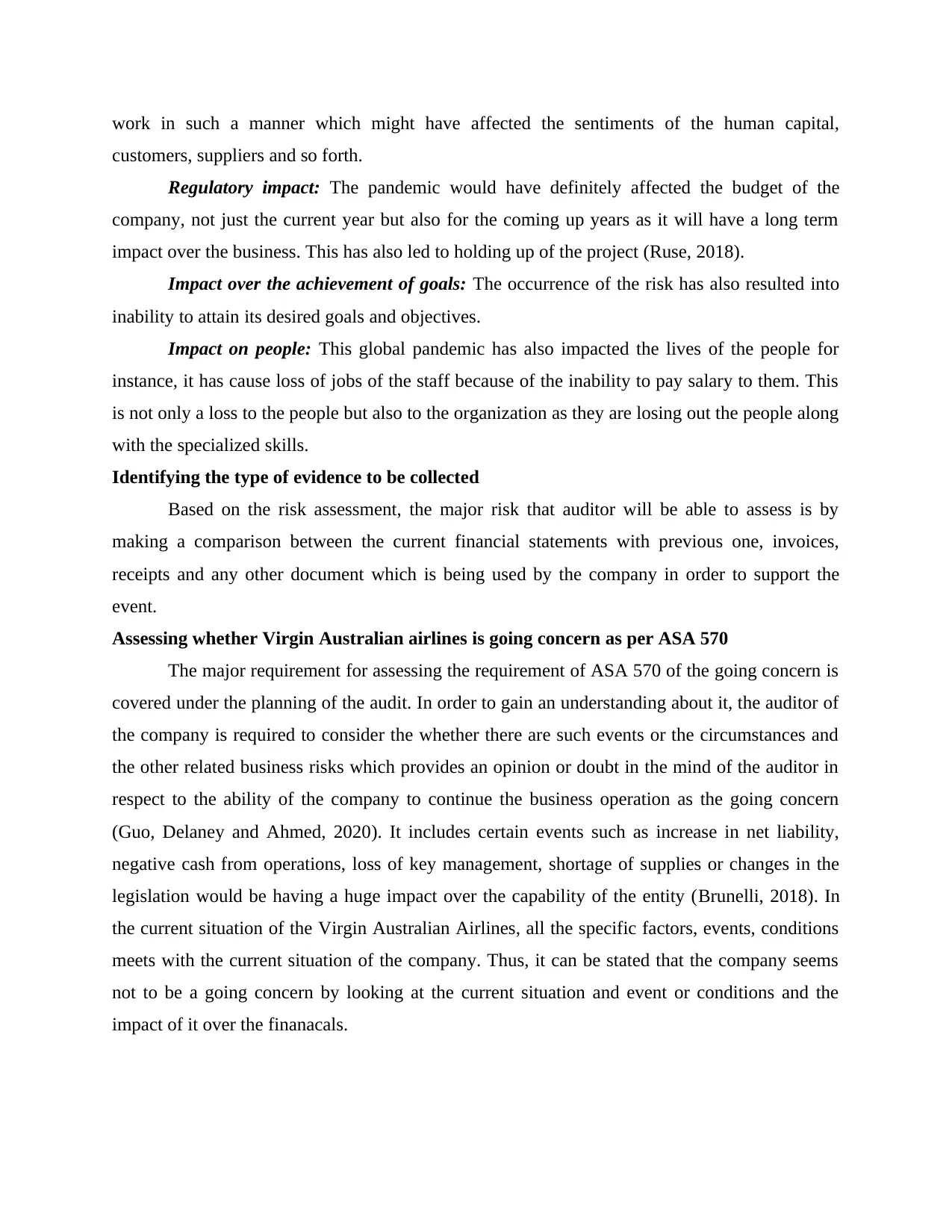
work in such a manner which might have affected the sentiments of the human capital,
customers, suppliers and so forth.
Regulatory impact: The pandemic would have definitely affected the budget of the
company, not just the current year but also for the coming up years as it will have a long term
impact over the business. This has also led to holding up of the project (Ruse, 2018).
Impact over the achievement of goals: The occurrence of the risk has also resulted into
inability to attain its desired goals and objectives.
Impact on people: This global pandemic has also impacted the lives of the people for
instance, it has cause loss of jobs of the staff because of the inability to pay salary to them. This
is not only a loss to the people but also to the organization as they are losing out the people along
with the specialized skills.
Identifying the type of evidence to be collected
Based on the risk assessment, the major risk that auditor will be able to assess is by
making a comparison between the current financial statements with previous one, invoices,
receipts and any other document which is being used by the company in order to support the
event.
Assessing whether Virgin Australian airlines is going concern as per ASA 570
The major requirement for assessing the requirement of ASA 570 of the going concern is
covered under the planning of the audit. In order to gain an understanding about it, the auditor of
the company is required to consider the whether there are such events or the circumstances and
the other related business risks which provides an opinion or doubt in the mind of the auditor in
respect to the ability of the company to continue the business operation as the going concern
(Guo, Delaney and Ahmed, 2020). It includes certain events such as increase in net liability,
negative cash from operations, loss of key management, shortage of supplies or changes in the
legislation would be having a huge impact over the capability of the entity (Brunelli, 2018). In
the current situation of the Virgin Australian Airlines, all the specific factors, events, conditions
meets with the current situation of the company. Thus, it can be stated that the company seems
not to be a going concern by looking at the current situation and event or conditions and the
impact of it over the finanacals.
customers, suppliers and so forth.
Regulatory impact: The pandemic would have definitely affected the budget of the
company, not just the current year but also for the coming up years as it will have a long term
impact over the business. This has also led to holding up of the project (Ruse, 2018).
Impact over the achievement of goals: The occurrence of the risk has also resulted into
inability to attain its desired goals and objectives.
Impact on people: This global pandemic has also impacted the lives of the people for
instance, it has cause loss of jobs of the staff because of the inability to pay salary to them. This
is not only a loss to the people but also to the organization as they are losing out the people along
with the specialized skills.
Identifying the type of evidence to be collected
Based on the risk assessment, the major risk that auditor will be able to assess is by
making a comparison between the current financial statements with previous one, invoices,
receipts and any other document which is being used by the company in order to support the
event.
Assessing whether Virgin Australian airlines is going concern as per ASA 570
The major requirement for assessing the requirement of ASA 570 of the going concern is
covered under the planning of the audit. In order to gain an understanding about it, the auditor of
the company is required to consider the whether there are such events or the circumstances and
the other related business risks which provides an opinion or doubt in the mind of the auditor in
respect to the ability of the company to continue the business operation as the going concern
(Guo, Delaney and Ahmed, 2020). It includes certain events such as increase in net liability,
negative cash from operations, loss of key management, shortage of supplies or changes in the
legislation would be having a huge impact over the capability of the entity (Brunelli, 2018). In
the current situation of the Virgin Australian Airlines, all the specific factors, events, conditions
meets with the current situation of the company. Thus, it can be stated that the company seems
not to be a going concern by looking at the current situation and event or conditions and the
impact of it over the finanacals.
Paraphrase This Document
Need a fresh take? Get an instant paraphrase of this document with our AI Paraphraser
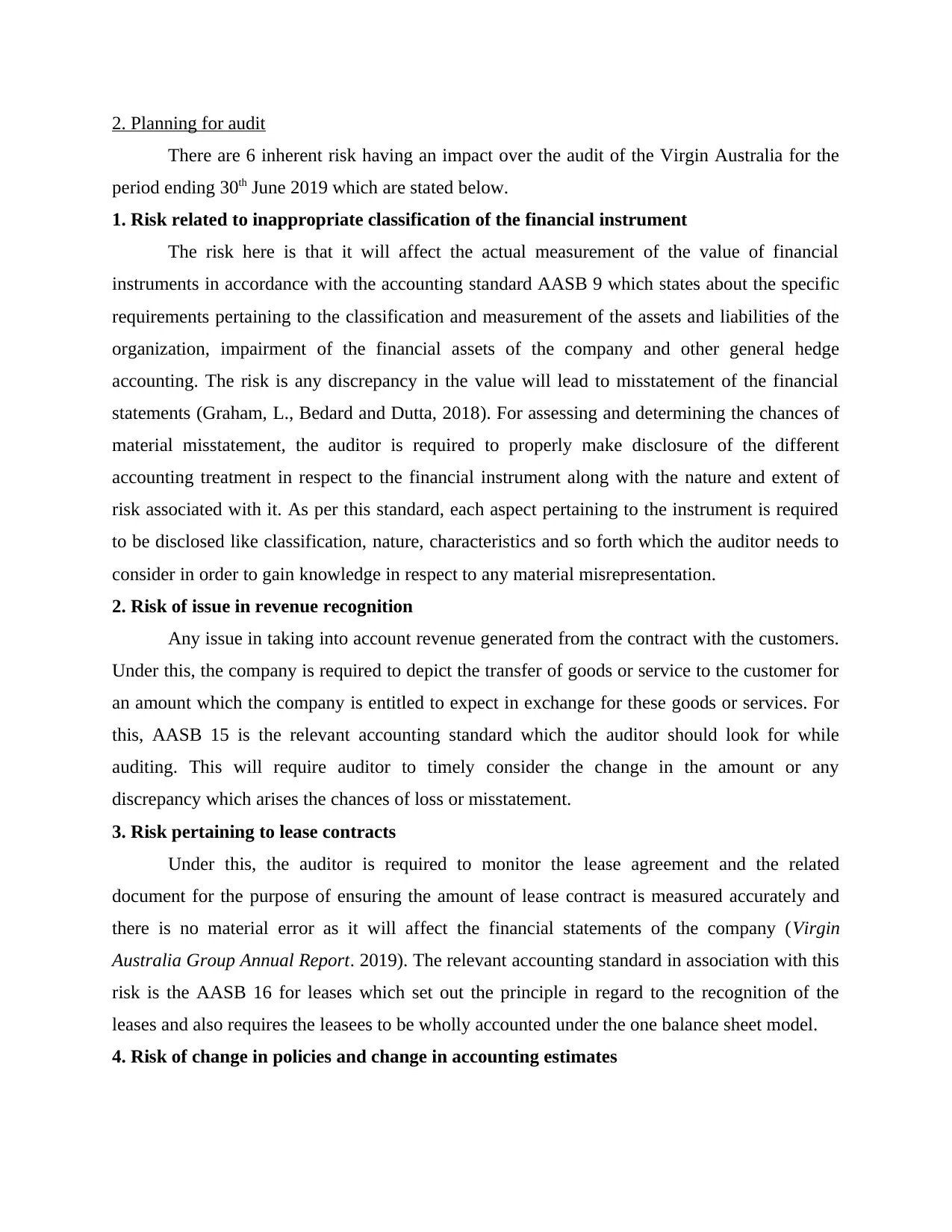
2. Planning for audit
There are 6 inherent risk having an impact over the audit of the Virgin Australia for the
period ending 30th June 2019 which are stated below.
1. Risk related to inappropriate classification of the financial instrument
The risk here is that it will affect the actual measurement of the value of financial
instruments in accordance with the accounting standard AASB 9 which states about the specific
requirements pertaining to the classification and measurement of the assets and liabilities of the
organization, impairment of the financial assets of the company and other general hedge
accounting. The risk is any discrepancy in the value will lead to misstatement of the financial
statements (Graham, L., Bedard and Dutta, 2018). For assessing and determining the chances of
material misstatement, the auditor is required to properly make disclosure of the different
accounting treatment in respect to the financial instrument along with the nature and extent of
risk associated with it. As per this standard, each aspect pertaining to the instrument is required
to be disclosed like classification, nature, characteristics and so forth which the auditor needs to
consider in order to gain knowledge in respect to any material misrepresentation.
2. Risk of issue in revenue recognition
Any issue in taking into account revenue generated from the contract with the customers.
Under this, the company is required to depict the transfer of goods or service to the customer for
an amount which the company is entitled to expect in exchange for these goods or services. For
this, AASB 15 is the relevant accounting standard which the auditor should look for while
auditing. This will require auditor to timely consider the change in the amount or any
discrepancy which arises the chances of loss or misstatement.
3. Risk pertaining to lease contracts
Under this, the auditor is required to monitor the lease agreement and the related
document for the purpose of ensuring the amount of lease contract is measured accurately and
there is no material error as it will affect the financial statements of the company (Virgin
Australia Group Annual Report. 2019). The relevant accounting standard in association with this
risk is the AASB 16 for leases which set out the principle in regard to the recognition of the
leases and also requires the leasees to be wholly accounted under the one balance sheet model.
4. Risk of change in policies and change in accounting estimates
There are 6 inherent risk having an impact over the audit of the Virgin Australia for the
period ending 30th June 2019 which are stated below.
1. Risk related to inappropriate classification of the financial instrument
The risk here is that it will affect the actual measurement of the value of financial
instruments in accordance with the accounting standard AASB 9 which states about the specific
requirements pertaining to the classification and measurement of the assets and liabilities of the
organization, impairment of the financial assets of the company and other general hedge
accounting. The risk is any discrepancy in the value will lead to misstatement of the financial
statements (Graham, L., Bedard and Dutta, 2018). For assessing and determining the chances of
material misstatement, the auditor is required to properly make disclosure of the different
accounting treatment in respect to the financial instrument along with the nature and extent of
risk associated with it. As per this standard, each aspect pertaining to the instrument is required
to be disclosed like classification, nature, characteristics and so forth which the auditor needs to
consider in order to gain knowledge in respect to any material misrepresentation.
2. Risk of issue in revenue recognition
Any issue in taking into account revenue generated from the contract with the customers.
Under this, the company is required to depict the transfer of goods or service to the customer for
an amount which the company is entitled to expect in exchange for these goods or services. For
this, AASB 15 is the relevant accounting standard which the auditor should look for while
auditing. This will require auditor to timely consider the change in the amount or any
discrepancy which arises the chances of loss or misstatement.
3. Risk pertaining to lease contracts
Under this, the auditor is required to monitor the lease agreement and the related
document for the purpose of ensuring the amount of lease contract is measured accurately and
there is no material error as it will affect the financial statements of the company (Virgin
Australia Group Annual Report. 2019). The relevant accounting standard in association with this
risk is the AASB 16 for leases which set out the principle in regard to the recognition of the
leases and also requires the leasees to be wholly accounted under the one balance sheet model.
4. Risk of change in policies and change in accounting estimates
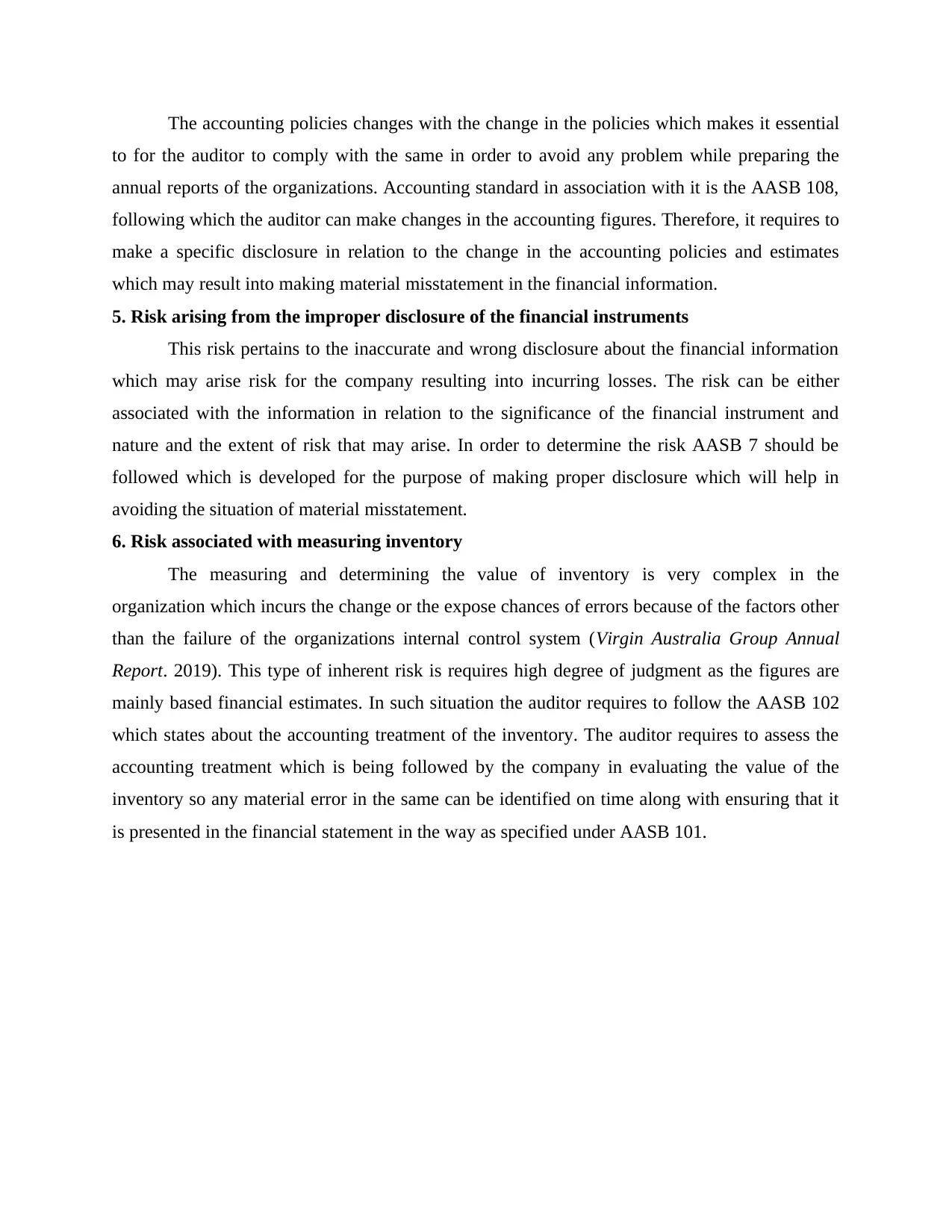
The accounting policies changes with the change in the policies which makes it essential
to for the auditor to comply with the same in order to avoid any problem while preparing the
annual reports of the organizations. Accounting standard in association with it is the AASB 108,
following which the auditor can make changes in the accounting figures. Therefore, it requires to
make a specific disclosure in relation to the change in the accounting policies and estimates
which may result into making material misstatement in the financial information.
5. Risk arising from the improper disclosure of the financial instruments
This risk pertains to the inaccurate and wrong disclosure about the financial information
which may arise risk for the company resulting into incurring losses. The risk can be either
associated with the information in relation to the significance of the financial instrument and
nature and the extent of risk that may arise. In order to determine the risk AASB 7 should be
followed which is developed for the purpose of making proper disclosure which will help in
avoiding the situation of material misstatement.
6. Risk associated with measuring inventory
The measuring and determining the value of inventory is very complex in the
organization which incurs the change or the expose chances of errors because of the factors other
than the failure of the organizations internal control system (Virgin Australia Group Annual
Report. 2019). This type of inherent risk is requires high degree of judgment as the figures are
mainly based financial estimates. In such situation the auditor requires to follow the AASB 102
which states about the accounting treatment of the inventory. The auditor requires to assess the
accounting treatment which is being followed by the company in evaluating the value of the
inventory so any material error in the same can be identified on time along with ensuring that it
is presented in the financial statement in the way as specified under AASB 101.
to for the auditor to comply with the same in order to avoid any problem while preparing the
annual reports of the organizations. Accounting standard in association with it is the AASB 108,
following which the auditor can make changes in the accounting figures. Therefore, it requires to
make a specific disclosure in relation to the change in the accounting policies and estimates
which may result into making material misstatement in the financial information.
5. Risk arising from the improper disclosure of the financial instruments
This risk pertains to the inaccurate and wrong disclosure about the financial information
which may arise risk for the company resulting into incurring losses. The risk can be either
associated with the information in relation to the significance of the financial instrument and
nature and the extent of risk that may arise. In order to determine the risk AASB 7 should be
followed which is developed for the purpose of making proper disclosure which will help in
avoiding the situation of material misstatement.
6. Risk associated with measuring inventory
The measuring and determining the value of inventory is very complex in the
organization which incurs the change or the expose chances of errors because of the factors other
than the failure of the organizations internal control system (Virgin Australia Group Annual
Report. 2019). This type of inherent risk is requires high degree of judgment as the figures are
mainly based financial estimates. In such situation the auditor requires to follow the AASB 102
which states about the accounting treatment of the inventory. The auditor requires to assess the
accounting treatment which is being followed by the company in evaluating the value of the
inventory so any material error in the same can be identified on time along with ensuring that it
is presented in the financial statement in the way as specified under AASB 101.
⊘ This is a preview!⊘
Do you want full access?
Subscribe today to unlock all pages.

Trusted by 1+ million students worldwide
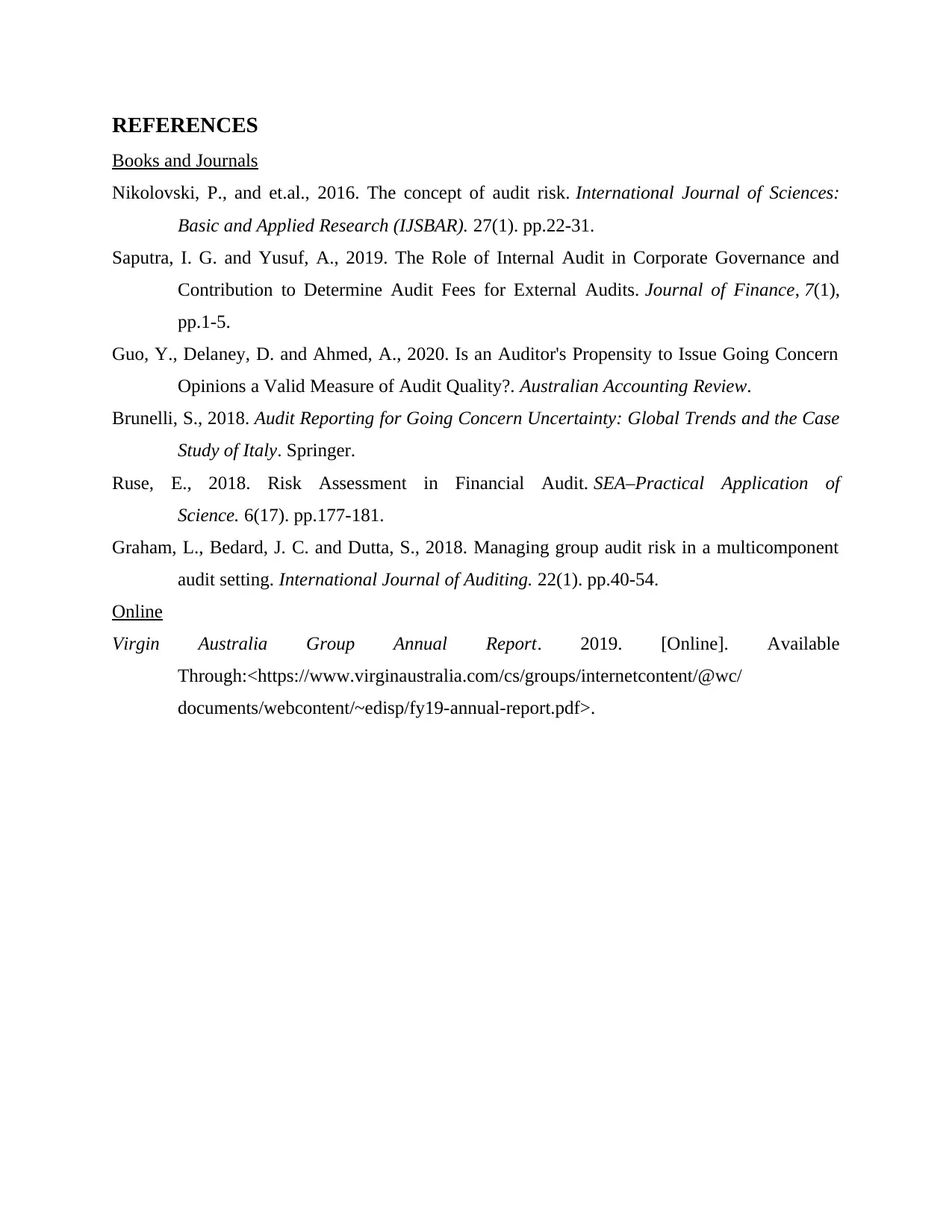
REFERENCES
Books and Journals
Nikolovski, P., and et.al., 2016. The concept of audit risk. International Journal of Sciences:
Basic and Applied Research (IJSBAR). 27(1). pp.22-31.
Saputra, I. G. and Yusuf, A., 2019. The Role of Internal Audit in Corporate Governance and
Contribution to Determine Audit Fees for External Audits. Journal of Finance, 7(1),
pp.1-5.
Guo, Y., Delaney, D. and Ahmed, A., 2020. Is an Auditor's Propensity to Issue Going Concern
Opinions a Valid Measure of Audit Quality?. Australian Accounting Review.
Brunelli, S., 2018. Audit Reporting for Going Concern Uncertainty: Global Trends and the Case
Study of Italy. Springer.
Ruse, E., 2018. Risk Assessment in Financial Audit. SEA–Practical Application of
Science. 6(17). pp.177-181.
Graham, L., Bedard, J. C. and Dutta, S., 2018. Managing group audit risk in a multicomponent
audit setting. International Journal of Auditing. 22(1). pp.40-54.
Online
Virgin Australia Group Annual Report. 2019. [Online]. Available
Through:<https://www.virginaustralia.com/cs/groups/internetcontent/@wc/
documents/webcontent/~edisp/fy19-annual-report.pdf>.
Books and Journals
Nikolovski, P., and et.al., 2016. The concept of audit risk. International Journal of Sciences:
Basic and Applied Research (IJSBAR). 27(1). pp.22-31.
Saputra, I. G. and Yusuf, A., 2019. The Role of Internal Audit in Corporate Governance and
Contribution to Determine Audit Fees for External Audits. Journal of Finance, 7(1),
pp.1-5.
Guo, Y., Delaney, D. and Ahmed, A., 2020. Is an Auditor's Propensity to Issue Going Concern
Opinions a Valid Measure of Audit Quality?. Australian Accounting Review.
Brunelli, S., 2018. Audit Reporting for Going Concern Uncertainty: Global Trends and the Case
Study of Italy. Springer.
Ruse, E., 2018. Risk Assessment in Financial Audit. SEA–Practical Application of
Science. 6(17). pp.177-181.
Graham, L., Bedard, J. C. and Dutta, S., 2018. Managing group audit risk in a multicomponent
audit setting. International Journal of Auditing. 22(1). pp.40-54.
Online
Virgin Australia Group Annual Report. 2019. [Online]. Available
Through:<https://www.virginaustralia.com/cs/groups/internetcontent/@wc/
documents/webcontent/~edisp/fy19-annual-report.pdf>.
1 out of 7
Related Documents
Your All-in-One AI-Powered Toolkit for Academic Success.
+13062052269
info@desklib.com
Available 24*7 on WhatsApp / Email
![[object Object]](/_next/static/media/star-bottom.7253800d.svg)
Unlock your academic potential
Copyright © 2020–2025 A2Z Services. All Rights Reserved. Developed and managed by ZUCOL.




